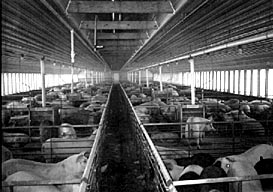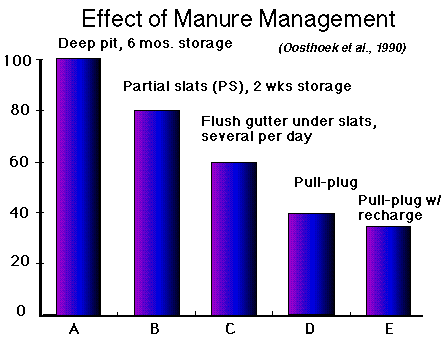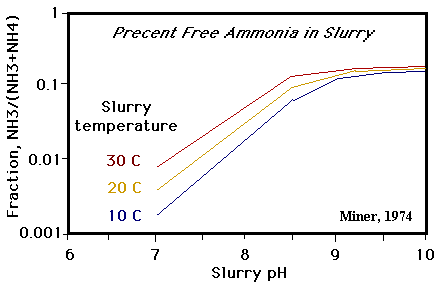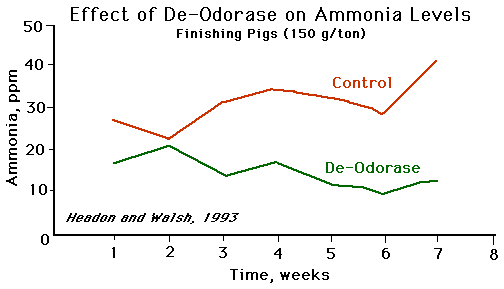

Ammonia
is the most important gas healthwise found in swine buildings
on a day-to-day basis because it can occur at levels high
enough to be an irritant to the respiratory system. The recommended
maximum gas concentrations suggested by OSHA (25 ppm) are
much higher than those suggested by agricultural scientists
in Europe (10 ppm).
Many studies have been done over the last several years in
Europe and North America to see what can be done to reduce
indoor levels of ammonia gas through building design and management
practices, Table 1. From these studies, it doesn't seem like
any single solution will do the job satisfactorily. Ammonia
gas can be significantly reduced if the right things are done
simultaneously with available methods and management practices
that involve ventilation, manure management, building hygiene,
and feed management. Implementing these strategies for ammonia
reduction in swine buildings may also reduce other manure
gases and odors.
Ventilation
Since additional airflow reduces contaminant levels, ammonia
control should be considered when choosing the minimum ventilation
rate. Proper ventilation will also require uniform distribution
of fresh air into the room. Air circulation fans or distribution
ducts improve the mix of indoor air during the winter. Air
speeds across manure-covered surfaces should be minimized
since the amount of ammonia gas given off by manure is increased
with air speed. In one experiment with 165 lb pigs, increasing
the air change rate from 2 to 4 air changes per hour increased
the quantity of ammonia released from 250 to 350 mg/hour.
The design, location, and management of ventilation inlets
can affect air speeds across the floor and over the pit surface.
Make sure the inlets are working properly. Most incoming air
jets in cold weather should travel across the ceiling first
and then down to the floor. By that time, the speed of the
fresh air is quite low. Exposed purlins and ceiling fixtures
can prematurely detach an air jet from the ceiling and direct
it down to the floor at relatively high air speeds. Air inlets
that direct incoming air down the wall can therefore increase
ammonia emissions into the room.
Ventilation fans that exhaust air directly from the pit reduce
manure gas concentrations in the room. When measurements of
hydrogen sulfide were taken with pit ventilation during manure
agitation, the concentrations were around 150 ppm under the
floor and only about 5 ppm above the floor. Without pit ventilation,
gas concentrations in the occupied parts of the room would
Have been dangerously high.
Air exhaust from the pit is not likely to increase air velocities
across the manure surface unless it is within two or three
diameters away from the discharge hole in a duct or the exhaust
fan. Do not overfill a pit under slotted floors--leave at
least 12 inches between the bottom of slat supports and the
top of the manure.
There will be some ammonia in the room even with well-designed
pit ventilation, because ammonia offgassing will also come
from urine and manure that accumulates on the slats and other
room and equipment surfaces. In some cases, the pit contributes
only a minor portion of total ammonia gas. Keep bedding, animal
pens, and feeding areas dry to slow down manure decomposition.
Ventilate to dry wet areas quickly or add new bedding.
Make sure fresh air doesn't enter the building through the
manure pit, e.g. through uncovered pump-out ports. This may
happen with wind-induced back pressure on the pit ventilation
fans, especially variable-speed pit fans which are extremely
vulnerable to wind at low speeds, e.g. < 50% of maximum.
Include an air trap in drain lines to reduce backdraft of
manure gases from an outside storage.
Another situation which probably occurs more frequently is
ventilation air entering and leaving the pit. High speed air,
in spite of pit ventilation, will "scour" ammonia
gas into the room. Reduce the speed of air entering the pit
to avoid this problem. For this reason, duct-type pit ventilation
is probably more effective than fans only.
Wet scrubbing reduced ammonia levels by 40% in recent tests.
Air was forced up through a shaft filled with thousands of
small pieces of inert plastic, against a downward flow of
water. It also removed a significant amount of dust particles,
bacterial and fungal spores,
and carbon dioxide. Scrubbers can also remove more than 90%
of odorous gases; however, the technique is relatively expensive
at the present time.
Manure Management
To reduce ammonia levels, avoid storing manure in the building
for long periods. The rate of ammonia released from manure
increases for storage times longer than about one day. However,
there are no further reductions in ammonia release rates for
less than one day because so much comes from dirty surfaces
(slats, floor, animals, etc.). Ammonia production peaks at
three days and again at 21 days. Frequent manure removal helps
maintain low ammonia gas levels. Removing manure frequently
to reduce ammonia is more effective with poultry than with
swine because ammonia formation takes place mainly from the
swine's urine. This occurs so rapidly that cleaning intervals
in swine buildings would have to be at least half-hourly and
the urine, in particular, would have to be removed as completely
as possible. This can be done efficiently only with flushing
systems since surface scrapers always leave behind a film
of urine on the surface, from which emission takes place.
European researchers are developing gutter scrapers that automatically
separate the liquid from the solids.

Researchers
in The Netherlands compared the relative ammonia emissions
for five different manure collection systems, Figure 1. Total
slotted floors with deep pit and long-term storage generated
the most ammonia gas. The building with a partially slatted
floor and manure pit produced 20% lower ammonia emissions.
A partly-slatted floor combined with a sloping floor under
the slats from which manure was flushed several times a day
was 30% below that for a deep pit. Greater emission reductions
were achieved when manure was collected under the slatted
floor in about 4 inches of flushing water so manure that falls
into liquid and solids are submerged. If the mixture was regularly
pumped out and replaced by new flushing liquid (as in pit
recharge), the reduction was 60%.
Using the "pull plug with recharge" or "fill
and empty" principle of manure removal, the reduction
increased to 70%. In this last case, pipes were laid under
the floor of the manure pit leading to the outside manure
storage. Inlets to these drain pipes were placed at regular
intervals in the floor. The drains could be closed with plugs,
shut-off balls, or gate valves. When opened, the slurry or
flushing liquid flowed out without significant surface turbulence
into the outside liquid manure storage. The openings are then
closed and new flushing liquid added to the pit. The results
of these tests agree with Canadian researchers who stated
that there is no advantage to continuous flow gutters, flush
gutters, or scraped gutters over fill-and-empty gutters in
terms of ammonia production.
Treatment of liquid manure pits to reduce offgassing will
have one of the following objectives: (1) to develop an aerobic
system, (2) to enhance anaerobic conditions, or (3) to stop
microbial activity. Aerobic systems involve the use of aeration
pumps and continual agitation, and have high energy and maintenance
costs. Additionally, restarting aeration following repairs
of the system can cause acutely toxic conditions by stripping
out anaerobic gases that have built up in the manure.
Proper conditions in the pit for anaerobic conditions will
reduce the build-up of both solids and toxic gas. Anaerobic
conditions are difficult to attain because the loading rates,
solids content, ammonia content, buffering capacity, and temperature
must all be favorable. Attaining anaerobic conditions is most
probable in farrowing buildings where the loading rate is
relatively low.
Adding water to the pit reduces ammonia concentration in the
slurry by enhancing anaerobic conditions and diluting the
concentration of urine. Table 2 shows that manure composition
(solids vs. liquid) has a great effect on ammonia emissions.

Microbial
activity (and thus gas production) can be retarded by lowering
manure pH by adding acidic chemicals. However, reducing microbial
activity enhances solids buildup and retards waste stabilization.
This increases the potential of water pollution upon land
application.
Ammonia is highly water-soluble and can largely remain in
the water in the dissociated form as ammonium. Only that part
which is present in the unionized form can become volatile
and be released as a gas. The proportion of volatile ammonia
to total ammonia concentration in stored manure is a function
of manure pH and temperature. The higher the manure pH, the
more ammonia is present in the manure in volatile form. Figure
2 shows the relationships between pH, temperature and the
potential for release of ammonia gas. The greatest increase
in ammonia release occurs at high temperatures between a pH
of 7 and 10. Only small quantities are released at a pH<7.
Hardly any measurable amounts of free ammonia are present
when pH4.5 is maintained. Manure pit pH can be lowered by
adding nitric acid. Other acids that can be used are hydrochloric
acid, sulfuric acid, and phosphoric acid, but nitric acid
is the most popular since the other acids affect manure quality.
An even distribution of acid is needed and it will increase
the nitrogen content of the slurry. Be very cautious in handling
concentrated acids.
Chelated copper-sulfate solutions are used to slow down gas-producing
bacteria. Other chemicals which are sometimes added to pits
include paraformaldehyde, superphosphate, phosphoric acid,
and acetic and propionic acid. Crystalline hydrated aluminosilicates
(zeolites) are sometimes added to adsorb ammonia in the pits.
Well-managed and sufficient amounts of straw bedding will
reduce ammonia gas inside the building more than any other
solid manure management system. However, the overall emissions
to the outside atmosphere are the same due to higher losses
during storage and spreading. More dust is found in the building
with straw, and fungal spores will dominate airborne microorganisms.
The Dutch developed and tested a manure removal system for
partially-slotted floor swine buildings in which straw bedding
is used in the sleeping area of the pens. A filter net installed
beneath the slats collected the solid manure and straw, but
allowed the urine and waste water to drain into the pit. Both
fractions were daily removed from the barn. Odor was reduced
by 50% in the building with the manure solids separation system
compared to a similar building with under-slat manure storage.
Building Hygiene
Good building hygiene reduces ammonia emissions by reducing
the amount of manure-covered surface area. This includes the
pig's skin. The warm body of an animal, when covered with
wet manure, makes an area of accelerated bacterial growth
and ammonia production which is quickly vaporized into the
air by body heat. Keep pigs clean and dry.
Feed Management
Phase feeding with addition of synthetic amino acids can reduce
ammonia emissions, Table 3. Less manure through more efficient
feed utilization by the animal is a side benefit on top of
the nutritional benefits.

Substances
added to the slurry (2 oz/100 ft3 slurry at a cost
of $114/gal) or to the feed to reduce the release of ammonia
from the manure have not yet been tested over long periods
and their effectiveness is still debated. Substances added
to the feed appear to have a greater effect than slurry additives.
It is very difficult to compare and evaluate reports about
the use of these substances since there is presently no established
test procedure for them.
Feed additives based on yucca extracts are incorporated in
the feed at low levels (4 oz/ton, costs about $10.50/lb).
The additional costs are about $1.35-$1.50/ton of grow-finish
diets. Yucca extracts bind ammonia and prevents its release.
Ammonia levels are reduced by 1/3 to 1/2 according to recent
tests, Figure 3.
| Percentage Composition of Manure | Ammonia release | ||
| Feces | Urine | Water | (ug)NH3/h |
| 100% | ------ | ------ | 3.2 |
| ------ | 100% | ------ | 426.0 |
| 50% | 50% | ------ | 120.0 |
| 75% | 25% | ------ | 16.0 |
| 75% | ------ | 25% | 3.4 |
| 50% | ------ | 50% | 6.6 |
| 25% | ------ | 75% | 9.7 |
| 5% | ------ | 95% | 2.2 |
Disclaimer and Reproduction Information: Information in NASD does not represent NIOSH policy. Information included in NASD appears by permission of the author and/or copyright holder. More